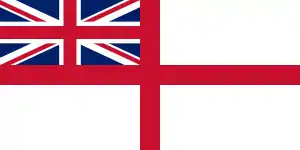Commandant General Royal Marines
The Commandant General Royal Marines is the professional head of the Royal Marines. The title has existed since 1943. The Commandant General Royal Marines is responsible for advising the First Sea Lord, with professional responsibility for all Royal Marine units; however his direct reporting line is to the Fleet Commander.[1] He is assisted by a Deputy Commandant General, whose rank is brigadier.[2] This position is not to be confused with Captain General Royal Marines, the ceremonial head. The Commandant General Royal Marines is the counterpart to the Commandant of the United States Marine Corps, although the latter is a full general.[3] He is based at Navy Command, as part of the headquarters staff.
| Office of the Commandant General Royal Marines | |
|---|---|
 Flag of the Commandant General Royal Marines | |
| Ministry of Defence | |
| Abbreviation | CGRM |
| Member of | Navy Command |
| Reports to | Fleet Commander |
| Nominator | Secretary of State for Defence |
| Appointer | Prime Minister Subject to formal approval by the Queen-in-Council |
| Term length | 1-4 years |
| Formation | 1825 |
| First holder | Major-General Sir James Campbell |
History
The professional head of the Royal Marines was the Deputy Adjutant-General from 1825[4] until 1914 when the post was re-designated the Adjutant-General:[5][6] the post holder usually held the rank of full general.[7] Since 1943 the professional head of the Royal Marines has been the Commandant-General who held the rank of full general until 1977, the rank of lieutenant general until 1996 and the rank of major-general since then.[8]
From 1825 until 1964 his headquarters office which changed location several times was known as the Royal Marine Office.[9][10]
Role as COMUKAMPHIBFOR
The appointment has been held concurrently with that of Commander United Kingdom Amphibious Forces (COMUKAMPHIBFOR) since the creation of the Fleet Battle Staff in 2001. COMUKAMPHIBFOR was one of two deployable two-star maritime operational commanders (the other being Commander UK Maritime Forces (COMUKMARFOR), now Commander United Kingdom Strike Force,[11] with particular responsibility for amphibious and littoral warfare.[11] Unlike COMUKMARFOR, COMUKAMPHIBFOR is primarily configured to command as a combined joint task force and designed to support a single two star commander.[11]
Present Role
In April 2018 it was announced that the two separate deployable two-star maritime operational commanders (COMUKMARFOR and COMUKAMPHIBFOR) would be merged into a single, larger, organisation.[12] This took place on 1 July 2019, whereupon the incumbent COMUKMARFOR took the title of Commander United Kingdom Strike Force (COMUKSTRKFOR), and responsibility for all the deployable elements of COMUKAMPHIBFOR. The Role of Commandant General Royal Marines remains in existence as the non-deployable head of the Royal Marines and the Senior Responsible Owner for the future of amphibious warfare and littoral strike capability, or Future Commando Force.[13]
General Officers Commanding
General Officers Commanding have included:[8]
Deputy Adjutant General Royal Marines
- Major-General Sir James Campbell 1825–1831
- Major-General Sir John Savage 1831–1836
- Lieutenant-General Sir John Owen 1836–1854
- Lieutenant-General Sir Robert Wesley 1854–1862
- General Sir George Langley 1862–1867
- General Samuel Lowder 1867–1872
- General Sir George Schomberg 1872–1875
- Lieutenant General George Rodney 1875–1878
- Major-General Sir Charles Adair 1878–1883
- General Sir John Williams 1883–1888
- General Sir Howard Jones 1888–1893
- General Sir Henry Tuson 1893–1900
- Lieutenant-General John Morris 1900–1902
- Lieutenant-General Sir William Wright 1902–1907
- General Sir William Adair 1907–1911
- General Sir William Nicholls 1911–1914
Adjutant General Royal Marines
- General Sir William Nicholls 1914–1916
- Major-General Sir David Mercer 1916–1920
- Major-General Gunning Campbell July 1920–November 1920
- General Sir Herbert Blumberg 1920–1924
- General Sir Alexander Hutchison 1924–1927
- General Sir Lewis Halliday 1927–1930
- General Sir Richard Ford 1930–1933[14]
- General Sir Richard Foster 1933–1936[15]
- General Sir William Godfrey 1936–1939
- General Sir Alan Bourne 1939-1943
Commandant General Royal Marines
| No. | Portrait | Name (Birth–Death) |
Term of office | Ref. | ||
|---|---|---|---|---|---|---|
| Took office | Left office | Time in office | ||||
| 1 | 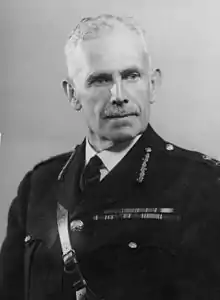 |
General Sir Thomas Hunton (1885–1970) |
January 1943 | 1946 | 2–3 years | – |
| 2 | General Sir Dallas Brooks (1896–1966) |
1946 | May 1949 | 2–3 years | – | |
| 3 | 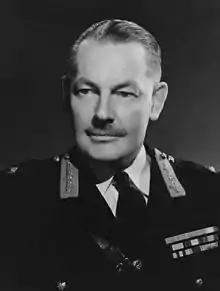 |
General Sir Leslie Hollis (1897–1963) |
1949 | 1952 | 2–3 years | – |
| 4 | General Sir John Westall (1901–1986) |
1952 | 1955 | 2–3 years | – | |
| 5 | General Sir Campbell Hardy (1906–1984) |
1955 | 1959 | 3–4 years | – | |
| 6 | General Sir Ian Riches (1908–1996) |
1959 | 1962 | 2–3 years | – | |
| 7 | General Sir Malcolm Cartwright-Taylor (1911–1969) |
1962 | 1965 | 2–3 years | – | |
| 8 | General Sir Norman Tailyour (1914–1979) |
1965 | 1968 | 2–3 years | – | |
| 9 | General Sir Peter Hellings (1916–1990) |
1968 | 1971 | 2–3 years | – | |
| 10 | General Sir Ian Gourlay (1920–2013) |
1971 | 9 June 1975 | 6–7 years | – | |
| 11 | General Sir Peter Whiteley (1920–2016) |
1975 | 1977 | 1–2 years | – | |
| 12 | Lieutenant General Sir John Richards (1927–2004) |
1977 | 1981 | 3–4 years | – | |
| 13 | Lieutenant General Sir Steuart Pringle (1928–2013) |
1981 | 1984 | 2–3 years | – | |
| 14 | .jpg.webp) |
Lieutenant General Sir Michael Wilkins (1933–1994) |
1984 | 1987 | 2–3 years | – |
| 15 | Lieutenant General Sir Martin Garrod (1935–2009) |
1987 | 1990 | 2–3 years | – | |
| 16 | Lieutenant General Sir Henry Beverley (born 1935) |
1990 | 1994 | 3–4 years | – | |
| 17 | Lieutenant General Sir Robin Ross (born 1939) |
1994 | 1996 | 1–2 years | – | |
| 18 | Major General David Pennefather (born 1945) |
1996 | 1998 | 1–2 years | – | |
| 19 | .jpg.webp) |
Major General Robert Fulton (born 1948) |
1998 | 2001 | 2–3 years | – |
| 20 | .jpg.webp) |
Major General Robert Fry (born 1951) |
2001 | 2002 | 0–1 years | – |
| 21 | Major General Tony Milton (born 1949) |
May 2002 | February 2004 | 1 year, 9 months | – | |
| 22 | .jpg.webp) |
Major General David Wilson (born 1949) |
February 2004 | August 2004 | 6 months | – |
| 23 |  |
Major General James Dutton (born 1954) |
August 2004 | June 2006 | 1 year, 10 months | – |
| 24 | .jpg.webp) |
Major General Garry Robison (born 1958) |
June 2006 | June 2009 | 3 years | – |
| 25 | 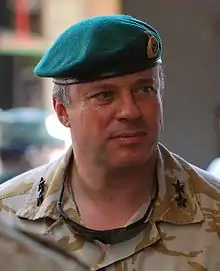 |
Major General Andy Salmon (born 1959) |
26 June 2009 | February 2010 | 7 months | – |
| 26 | .jpg.webp) |
Major General Buster Howes (born 1960) |
February 2010 | December 2011 | 1 year, 10 months | – |
| 27 | 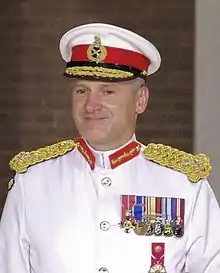 |
Major General Ed Davis (born 1963) |
December 2011 | 13 June 2014 | 2 years, 6 months | [16][17] |
| 28 | .jpg.webp) |
Major General Martin Smith (born 1962) |
13 June 2014 | 4 June 2016 | 1 year, 11 months | [17][18] |
| 29 | .jpg.webp) |
Major General Robert Magowan (born 1967) |
4 June 2016 | 19 January 2018 | 1 year, 7 months | [18][19] |
| 30 | .jpg.webp) |
Major General Charles Stickland (born 1968) |
19 January 2018 | 14 June 2019 | 1 year, 4 months | [19][20] |
| 31 | .jpg.webp) |
Major General Matthew Holmes (born 1967) |
14 June 2019 | Incumbent | 1 year, 7 months | [20] |
References
- Government, H.M. "MOD roles and salaries: 2016 - GOV.UK - Navy Command senior". www.gov.uk. Royal Navy, MOD, April 21016. Retrieved 9 August 2017.
- 08/11/2013 (2014-06-09). "Statement from Deputy Commandant General Royal Marines". Royal Navy. Retrieved 2014-06-14.CS1 maint: numeric names: authors list (link)
- "Marine Corps Leadership". Marine Corps. Retrieved 20 May 2016.
- "Royal Marines historical time line". Archived from the original on 10 March 2016. Retrieved 27 May 2016.
- "British Admiralty". Naval History. Retrieved 21 May 2016.
- "Punch, or the London Charivari". 11 February 1914. Retrieved 27 May 2016.
- "Navy List". Admiralty. Retrieved 21 May 2016.
- "Senior Royal Navy appointments" (PDF). Retrieved 20 May 2016.
- Office, Admiralty (December 1827). "Royal Marine Office". The Navy List. London, England: John Murray. p. 124.
- Archives, National (1688–1983). "Records of Royal Marines". nationalarchives.gov.uk. London, England: The National Archives. Retrieved 3 January 2019.
Division within ADM
- "Fleet Battle Staff". Royal Navy. Archived from the original on March 17, 2011. Retrieved 20 May 2016.CS1 maint: unfit URL (link)
- "Jane's – UK Amphibious Headquarters to Disappear in Merger". 20 April 2018. Retrieved 22 February 2020.
- "Future Amphibious Force". BMT. Retrieved 21 February 2020.
- "No. 33983". The London Gazette. 3 October 1933. p. 6355.
- "No. 34329". The London Gazette. 6 October 1936. p. 6363.
- City brigadier will lead Royal Marines Archived 2011-12-09 at the Wayback Machine This is Plymouth, 5 November 2011.
- "Commandant General Royal Marines Supersession". royalnavy.mod.uk. 18 June 2014. Retrieved 9 October 2020.
- "Supersession of the Commandant General Royal Marines (CGRM)". theroyalmarinescharity.org.uk. The Royal Marines Charity. 13 June 2016. Retrieved 9 October 2020.
- "Supersession of the Commandant General Royal Marines (CGRM)". theroyalmarinescharity.org.uk. The Royal Marines Charity. 19 January 2018. Retrieved 9 October 2020.
- "Supersession of the Commandant General Royal Marines (CGRM)". theroyalmarinescharity.org.uk. The Royal Marines Charity. 14 June 2019. Retrieved 9 October 2020.
